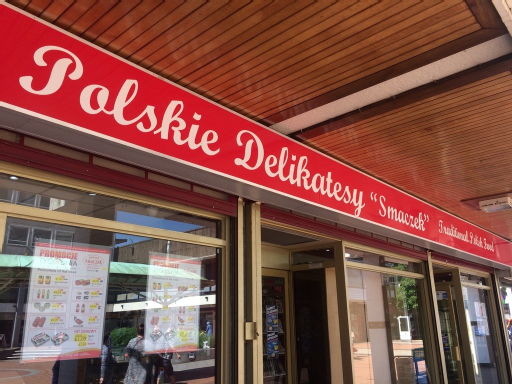Landscaping Project Blogs
Linguistic Landscaping Project
MultiDiv 2019 aimed to provide participants from Warwick and Monash with an interdisciplinary immersion experience in the study of multilingualism and diversity. Students collaborated in groups to conduct a linguistic landscaping project exploring multilingualism in the city of Coventry. The project involved a field trip to a number of locations in Coventry, including Coventry Central Library and St Francis of Assisi Church, to collect image and interview data on multilingualism in the city. Each group analysed their data and presented their findings to the other groups in order to build up a picture of the diverse linguistic landscape of Coventry. The teams then turned this work into blog posts.
Here is what our students wrote:
Linguistic Landscaping: An exploration of the relationship between signage and linguistic communities in Coventry, UK
Eloise Blaxall, Edward Dunbavin, Renate Plehwe & Arina Wijker
Abstract
This study aims to explore the relationship, if any, that exists between the linguistic evidence available in public spaces and the Census recording of languages present in the landscape. The research focuses on three locations in Coventry, UK and analyses a range of signage, interviews, and observations. Key findings include a high proportion of monolingual English signage in the city. There is a mismatch between what may be expected in the linguistic landscape based on the 2011 Census data and languages other than English found in the physical landscape. Qualitative findings suggest that speakers of languages other than English do not feel encouraged to speak their languages within Coventry, suggesting that the high representation of monolingual English signage is in line with the city’s ideologies and values.
Introduction
Coventry, the UK City of Culture for 2021, is currently considered a very diverse location, bringing together people from various cultural and linguistic backgrounds to create a multicultural atmosphere. Nevertheless, this multiculturalism is set against the backdrop of the wider UK context, in which English is considered a fundamental component of the broader UK identity. According to the latest Census data, Coventry is home to a growing number of people who have a first language other than English, which corresponds to a variety of languages being spoken in the community. Against the backdrop of English being highly valued within the community, it is possible that this could represent the potential for a clash in ideologies, values, and ideas with regard to how linguistic diversity may be represented and valued in a particular space.
To gain a better understanding of the language situation in Coventry, we have conducted research to find which languages are actually used in the area and how they are represented visually. This linguistic landscaping project is informed by the desire to discover to what extent the linguistic landscape corresponds to what might be expected from the known community demographics as based upon the 2011 Census data, with the aim of developing a greater understanding of the ways in which the community is affected by and engages with this atmosphere.
Theoretical framework & contextualisation
Everywhere around us are signs that tell us things, whether this is a traffic sign that dictates the permitted speed or the sign above a shop informing potential customers of what kind of shop it is. Signs can also give an insight into the languages that are actually used in a particular area, perhaps reflecting the languages spoken by the proprietors and clientele. This is considered an area’s linguistic landscape (Mooney & Evans, 2015). Landscapes in general reflect social meanings, ideas and values (Nash, 2005). It then follows that a linguistic landscape can be seen as a reflection of the languages spoken in a particular location, or, in other words, that they provide ‘visual proof of an invisible soundscape’ (Jones & Effamonh, 2019). As such, reflecting language as used by the people, a linguistic landscape ‘can provide insight into linguistic diversity not captured by official top-down discourses or official audits’, such as a census (Mooney & Evans, 2015, p. 97).
Multilingual signs can offer a variety of translation options. A sign can be classified as offering mutual or non-mutual translation depending on whether the messages on the signs are a direct translation of each other or not. When only a part of the message on the sign has been translated, the sign is classified as a partial translation (Backhaus, 2006, p. 58). Figure 1 shows a multilingual sign with mutual translation.
Figure 1: Mutual translation of a multilingual impermanent sign
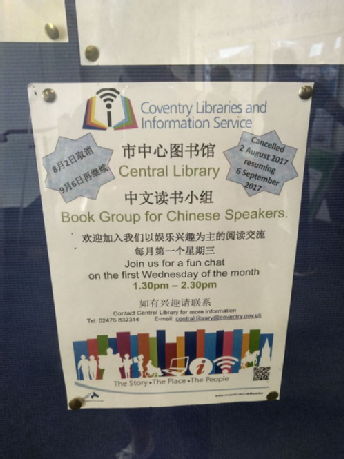
The Census data from 2011’s ONS Census (Office for National Statistics, 2011) suggests that the Coventry linguistic landscape should include a higher proportion of Punjabi and Polish material relative to other languages, due to the larger recorded populations of these linguistic groups.
Methodology
Data were collected on June 28, 2019, in three locations in the city of Coventry, UK (Figure 2). These were the Central Library, a large private company, and the Greyfriars Walk in the City Arcade. The locations were chosen on the basis of their different functions within the city, namely, Central Library is a social centre with a high focus on education, while the City Arcade is expected to reflect languages used by businesses and their customers for the purpose of prototypically communicative function rather than that used for a more official function. The company was chosen for its commercial purpose in the city and its important role in employing refugees. By collecting signage data within three locations in the city centre and cross-referencing these with narrative data collected at random from the general public, the research looks to determine the relationship between speaker populations and physical language representation.
Figure 2: Map of locations
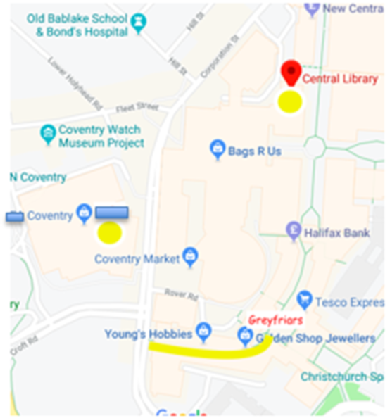
Data collection involved taking photographs of language on signs and was supplemented with unstructured interviews with library patrons and passers-by in the street, who were randomly selected. For our analysis, signs were classified as permanent signs and non-permanent signs as well as monolingual or multilingual. Monolingual relates to a sign in English only and multilingual to a sign using any amount of non-English language (Backhaus, 2006).
Multilingual signs were subsequently further classified on the basis on whether the languages were used for mutual, non-mutual, or partial translations.
Results
Upon collation and coding of the data, certain trends were immediately clear, particularly with regard to the way multilingualism was represented in the physical landscape. Somewhat unsurprisingly, it was found that the proportion of monolingual English signage is significantly higher than multilingual signage across the three locations surveyed, as shown in Table 1. There is, however, variation with regard to the exact proportion of this monolingualism and multilingualism across the three locations, with Greyfriars’ Walk in Central Arcade demonstrating the highest proportion of multilingualism and Central Library showing the lowest (Table 1).
Table 1: Signage Language vs Location

After surveying the landscape in the company, it was decided that the signage data collected in this location was predominantly informed by marketing and branding decisions. The multilingualism present in the company was heavily weighted toward Swedish partial translation, rather than designed for a particular, location-specific communicative purpose. Indeed, despite the Refugee employment programme in place, linguistic diversity in signage was not present. It was therefore decided that due to the material collected at this location being informed by branding rather than being a reflection of the city’s communicative needs, it would be excluded from subsequent analysis.
As the most linguistic diversity was present in Greyfriars Walk, the decision was made to concentrate on this location as the subsequent focus of our linguistic landscaping project. In this location, the ways in which monolingualism and multilingualism were represented were analysed, as were the differences in the way this was represented in permanent and impermanent signage. This information is shown in Table 2.
Table 2: Permanence vs Linguistic Feature in Greyfriars Walk
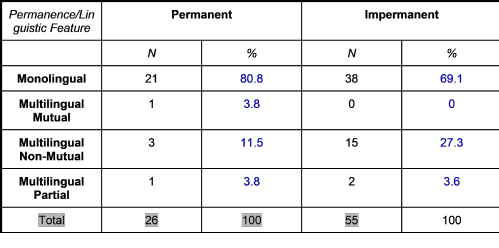
The languages present in the linguistic landscape of Greyfriars Walk (Table 3) include Chinese, Polish, Indian languages, French, and English. There is a discrepancy with the linguistic landscape in this location compared to the languages represented in the 2011 Census (Office for National Statistics, 2011). Perhaps the most noticeable discrepancy is the higher proportion of Chinese writing in the linguistic landscape, whereas only 0.8% of the 2011 Coventry population spoke dialects of Chinese (Table 4). This may be attributed in part to the age of the Census data or the particular location surveyed; additional research would need to be conducted to further support or refute this hypothesis.
Table 3: Language Frequency in Greyfriars Walk signage

Table 4: Languages spoken in Coventry, adapted from Census data (Office for National Statistics, 2011)

The interviews collected in all three locations reflected heavily upon the narratives of Coventry residents and visitors. These interviews were prompted by three semi-structured, open-ended questions to extract public perception on the languages spoken in Coventry regarding awareness of the materials available in a multilingual format and the opportunities available to the participants for them to speak in languages other than English.
The interviews indicated that the city of Coventry is home to a wide range of different experiences for speakers of different languages. For example, speakers of Punjabi, the highest recorded language used in Coventry after English (Census, 2011), suggested that they had no requirement or desire to access multilingual media due to an expansive community of speakers established within the city. Individuals whose languages constitute only a small proportion of the recorded language communities and whose languages were not provided for in the Central Library, such as Yoruba, felt that “other languages are not encouraged”.
It was also noted by a number of speakers that English was valued highly by speakers of Polish, Chinese, and French, whose choice to not engage in multilingual material was motivated by their desire to assimilate within the community. Other multilingual participants considered that their alternative languages were of more value than English as it allowed them greater access to well-established linguistic communities that English did not.
Table 5 summarises the qualitative findings of the interviews.
Table 5 : Interview Data Summary
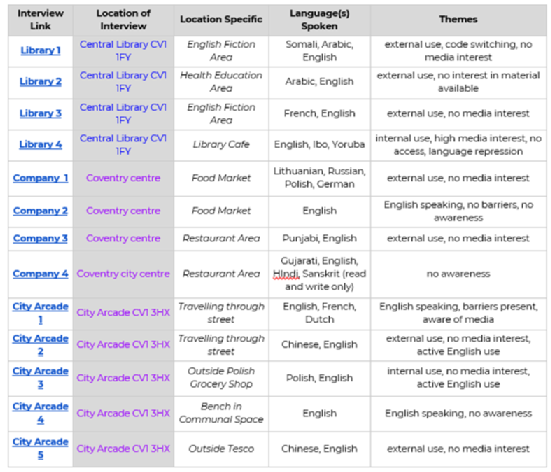
Discussion
Through interpreting the data collected it is evident that a discrepancy exists between the Census data and the expected presence of linguistic diversity through signage and media in public spaces. Given the recent influence of migration changes in the UK (Office for National Statistics, 2019) it would be expected that a rise in multilingual media would be evident, alongside the evidence of pre-existing linguistic communities that were recorded in the Census nearly a decade ago (Office for National Statistics, 2011). However, as discussed in the results of our research, this is not as visible in the linguistic landscape as we might have expected. Both signage values and interview narratives display a lack in multilingual media content, access, and awareness, which furthermore manifests itself as a rejection of linguistic diversity as corroborated by participants’ verbal interviews. Whilst the cultural diversity and acceptance of new communities in Coventry are clearly displayed through initiatives such as the TESOL classes available in the Central Library, the linguistic elements of intercultural emergence do not correspond in the same pattern in the physical environment.
Conclusion
Comparing the qualitative and quantitative findings of this study, it is clear that although significant cultural diversity is present in Coventry, this is not necessarily reflected in the linguistic landscape. The prominence of English reflects the widespread understanding that use of and proficiency in this language is currently absolutely necessary to be an active part of British society. Small pockets of increased linguistic diversity are present, particularly in spaces such as City Arcade that are not governed by a central organisation, such as a local authority (Central Library) or a corporation, although these are not reflective of what may be expected based on the most recent Census data (Office for National Statistics, 2011).
It is important to note that interview data suggests that individuals from non-English speaking backgrounds may not necessarily feel encouraged to use or maintain their languages in the Coventry community, or to contain this feature within pre-established closed communities. Given the city’s new title as the UK City of Culture for 2021, the absence of encouraged multilingualism within the community is not necessarily as consistent as it could be with the expectations of this award. Increasing the presence of multilingualism within the linguistic landscape may be one way to address the concerns and feelings of the city’s population and may help to make multilingual speakers feel welcomed in the city.
References
Backhaus, P. (2006). Multilingualism in Tokyo. International Journal of Multilingualism, 3(1), 52-66. doi:10.1080/14790710608668385
Nash, C. (2005). Landscapes. In P. Cloke, P Crang, and M. Goodwin (Eds.), Introducing Human Geography (pp.156-167). Oxon: Hodder Arnold.
Jones, S. & Effamonh, S. (2019, January 18). Ethnic Businesses in the Neighbourhoods of Tunnel and La Borde [Blog post]. Retrieved from https://sepia2.unil.ch/wp/garrido/?cat=-1
Mooney, A., & Evans, B. (2015). Linguistic landscapes. In A. Mooney and B. Evans (eds.), Language, Society and Power: an introduction. London: Routledge, pp. 86-107.
Office for National Statistics (2011). Census 2011. Retrieved from https://www.ons.gov.uk/census/2011census
Office for National Statistics (2019). Migration statistics quarterly report: May 2019. Retrieved from https://www.ons.gov.uk/peoplepopulationandcommunity/populationandmigration/internationalmigration/bulletins/migrationstatisticsquarterlyreport/may2019
Monolingually Multicultural: A Linguistic Landscape of Coventry
Gadis Pratiwi, Ayten Alibaba, Zeena Faulk, Emily Kirkman & Sally Cummins
Abstract
This study aimed to investigate the ways in which multilingualism is represented in the English city of Coventry. As a city in which many different nationalities, cultures and languages have settled post WW2, the city offers a rich linguistic landscape within which to work. We aimed to identify the ways in which both official and unofficial signage in institutions and in the public sphere demonstrate the multilingualism of the city and how these signs help develop and display the identity of Coventry as a city. We employed a mixed-methods research design, encompassing images of signs from around the Central Library and surrounds, census data, as well as qualitative interviews of locals and employees of the Central Library and Marketplace.
Whilst Coventry does indeed appear to be a multicultural city, the findings of this study show that this is not necessarily represented in their signage. Of the 185 images taken for this study, 124 (67%) of them were English only – 58 official signs and 66 non-official signs. The next most common language seen in signs was English mixed with Chinese (Mandarin and Cantonese), yet these findings are in contrast with the most recent census data (2011) which puts the Chinese population of Coventry at just 0.84% of the total population. The city’s signs offer us a way of seeing how the linguistic landscape is changing, with this being seen most notably in the unofficial signs of the city. English remains an important bridge between the many cultures that inhabit the city of Coventry, but the city itself seems to celebrate its multiculturalism in a monolingual fashion.
Introduction
We formed a group of five students from Monash University and the University of Warwick, all interested in investigating the linguistic landscape of Coventry. We were encouraged by the latest nomination of Coventry as the City of Culture of 2021. Multiculturalism means multilingualism, doesn’t it?
Figure 1. Does multiculturalism mean multilingualism?
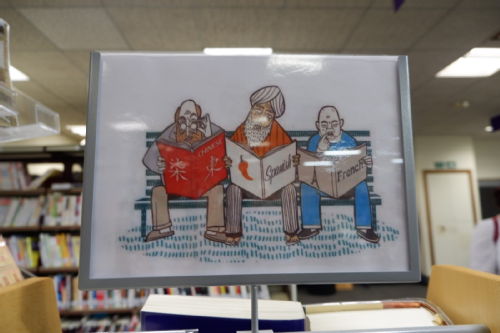
We set out to investigate the official and unofficial representation of multilingualism in Coventry and how that helps to create its identity as a city. To survey the entire city of Coventry in a day is unrealistic. Thus we decided to limit our investigation to the Central Library – an official site funded by the City Council - and on what lies on the L-shaped road leading to the library from the 12X bus stop. Our plan was to speak to the library staff and library visitors and to observe if and where languages other than English are used. On the L-road there was scattered many Chinese businesses with signage showing either mutual translations or only Chinese words depending on the customers they were targeting. Some ads and posts only in Asian languages appeared on that road as well. There were also several food stalls on the way to the library, offering European, Asian and Middle Eastern fast foods to customers of all nationalities. On these stalls, English was the dominant language, but individual foreign languages appeared, too.
Off the library road is the Coventry market where we investigated to determine whether the signage trends of the Library were similar here. In the market, English was still dominant, yet other languages appeared on food and grocery items as well. Chinese was particularly observed in unofficial signs marking foods and prices. Similarly, we could hear different languages spoken by different vendors and customers.
Figure 2. Japanese language used alongside with English
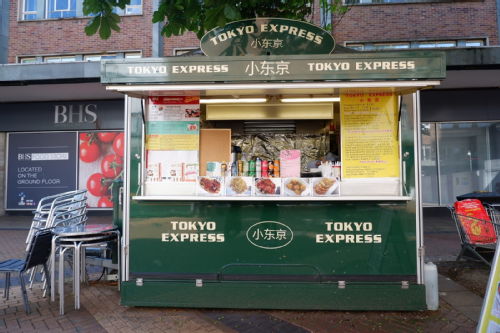
In the Central Library, two library staff members greeted us and took us on a quick tour through the limited non-English sections on the 1st floor. We headed upstairs to the ‘World Zone’, a section in the back distinctly marking foreign bookshelves – only that all the marking was in English. The location of the foreign books from Asia, the Middle East, and Europe made us wonder how many migrants knew about them and could read the English signs.
Methodology
This linguistic landscape in Coventry Central Library, Coventry Market, and surrounding areas was done quantitatively and qualitatively. We observed and took photos of the signs and conducted interviews to see how people use languages in the community as well as people’s perceptions of the multilingual and multicultural city. Semi-structured interview techniques were used. We asked people (1) what their mother tongue was, (2) what language they use in the library or the market, (3) why they choose the language, (4) if they encounter any problems regarding their preferences of languages, and (5) if there is anything they would change about the way language is used in Coventry.
After taking photos of signs around Coventry, we uploaded and started to categorize the photos as either official or non-official. As in Ben-Rafael, Shohamy, Amara, and Trumper-Hecht (2006), we determined official signs as public signs of general interest, public announcement, signs of street names, and permanent or fixed signs. The non-official signs are ‘bottom-up’ signs such as shop signs, private business, private announcements, and non-permanent signs, which are usually printed and portable versions. The 185 signs used in our analysis are comprised of 73 official signs and 112 non-official signs. In our interviews, we focussed on themes such as monolingualism, multilingualism, (dis)advantages of having a language other than English as a mother tongue, using the library as a space for interaction, personal identity, the identity of Coventry as a city, religion, and ethnicity. However, once we started coding our interview data more themes emerged and these were also taken into account in our analysis. The details of our findings are explained in the following paragraphs.
Analysis & Discussion
We observed that English was the dominant language used on signs in the areas of our research in Coventry. 67% of all signs were in English only, 17.3% were composed in English and Chinese and other Far Eastern Asian languages, 3.8% English and Arabic languages, and English and Indian languages form the 2.7% of the total signs that were investigated.
After contrasting our data with the 2011 census data, we observed contradictory findings. 2011 census data states that Chinese speakers (Mandarin, Cantonese and all other Chinese) make up just 0.84% of the Coventry population, however according to our data 14.6% of the all signs we observed had a form of Chinese language. This indicates an increase in Chinese speakers in the Coventry area between 2011 and present day. This is assumed to be related to the ongoing transformation of the city centre and the high rise of the Chinese-speaking students arriving to study both at the University of Warwick and Coventry University.
Figure 3. Monolingual Chinese sign
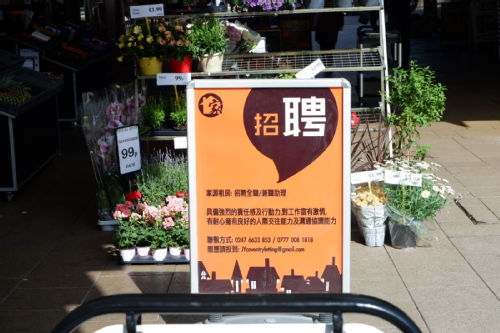
In addition to the visual and census data, we also conducted semi-structured interviews. The themes that emerged from the interviews included (1) loss of heritage language, (2) perceived prejudices towards non-English speakers, (3) complaints about the non-English language books in the library and (4) the perception of English as a ‘prestigious’ language. In line with one of the Central library’s aims, the interviewees also tended to use the library’s space for social gatherings, presumably with the aim of bringing various migrant groups together. This contributes to the construction of a community feeling in a larger sense.
When in Coventry Central Library, we noted not only the amount of signage in only English but also its prominent placement in all other signs. For example, the main sign advertising the library’s “World Zone” was written solely in English and the signage for the foreign-language literature was written in English first and then the language of the literature. When speaking to those within the library there seemed to be little awareness that there were books written in their preferred languages and for those who were aware of the “World Zone” they often felt that their literary tastes were not adequately catered for. Surprisingly, the majority of the interviewees expressed their awareness of linguistic and cultural diversity in Coventry despite English being the dominant language that most interviewees use in their daily interactions with the groups of people outside their ethnic groups. In the library’s “Rhyme Time”, English is used by all the children and parents, yet all are encouraged to share their own cultures’ stories through the means of English, further suggesting the city’s acceptance of its multiculturalism, if not its multilingualism. Some interviewees mentioned that they keep their mother tongue sharp by signing up to informal social groups and language-specific associations within their communities.
Figure 4. The library provides Chinese storytelling and a book group for Chinese people
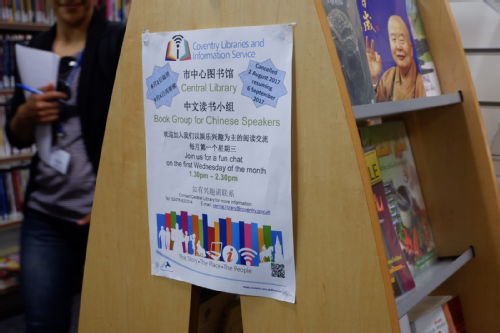
Conclusion
Coventry is quite clearly a multicultural city. However, this multiculturalism is yet to be realised in the languages present throughout Coventry. Though there were certainly signs across the city written in various languages, English was still the most dominant language, both in terms of the amount of signs in only English and also in English’s orthographic positioning in the multilingual signs. However, there seemed to be agreement amongst those who we interviewed that Coventry in general and the library specifically was making every attempt to create an environment where every culture and every language felt included and accepted. In this way there appeared to be a disjunct between the city’s perception and the reality of its multilingualism. One hypothesis we have presented to account for this difference is that English is used in Coventry as the lingua-franca, as the language that bridges the gap between the myriad languages spoken in the city. This, then, supports our idea that Coventry embraces multiculturalism but cannot yet identify as a multilingual city. One possible exception to this is in the marketplace, where unofficial signs are used throughout in multiple languages or even monolingual, non-English languages such as Mandarin. Here, English is still used as the lingua-franca, yet the use of these unofficial, non-English signs seems to encourage both mongers and shoppers alike to use their preferred languages, specifically the languages present on the signs. This endorses our previous observations of English being the lingua-franca throughout Coventry but suggests that the use of languages other than English, specifically Mandarin, may be growing in dominance and prominence.
References
Backhaus, P. (2006). Multilingualism in Tokyo: A look into the linguistic landscape. International Journal of Multilingualism. 3(1), 52-66. Doi: 10.1080/14790710608668385
Ben-Rafael, E., Shohamy, E., Amara, M. H., & Trumper-Hecht, N. (2006). Linguistic landscape as symbolic construction of the public space: The case of Israel. International Journal of Multilingualism, 3(1), 7-30. doi:10.1080/14790710608668383
Coventry's multilingual identity
Genie Jones, Alex Avella, Reem Doukmak, Lúcia Collischonn de Abreu & Sofia Stojic
This text was written thanks to the Monash Warwick Alliance Education Fund during the inaugural Sprinter School in Multilingualism and Diversity in Warwick University, June 2019. We the authors would like to acknowledge the efforts and generosity of University of Warwick and all the staff and students involved in making this Linguistic Landscaping project possible.
Introduction
Through the framework of linguistic landscaping and by collecting community members’ perceptions of multilingualism, this paper aims to establish the importance of multilingualism for Coventry’s identity. In visiting three sites of multilingual participation, including a church-based language and employment aid service for refugees, an Arabic restaurant established and run by the same church, and Coventry’s main bus station, this project has found English to be the majority language represented in the city’s signs. Despite census data which reports a strong presence of multiple speech communities, the city of Coventry appears to project more strongly a multicultural identity than a multilingual identity.
Theoretical Framework
The framework of linguistic landscaping refers to the “linguistic objects that mark a space” (Ben-Raphael et al, 2006) and examines the signs that are physically present in a specific environment, as a reflection of the languages and speakers present in the community. In doing so, linguistic landscaping may be used to reflect the disjunct between theory and practice in multilingual policy and linguistic reality. While official data such as census reports may imply the presence of minority language speakers, linguistic landscaping projects can reveal how they are tangibly realised in an environment by analysing the use of linguistic objects.
The linguistic objects in question may be understood as signs of varying permanence, function, and official status, where official signs are those commissioned by the government or other public services providers. Non-official signs are any signage or visual communication not commissioned by the government. A similarly important concept is that of mutual and non-mutual translation, where text may be partially or completely translated as an example of mutual translation, or not translated at all as an example of non-mutual translation. In our project, mutual translation referred to the cases of translation, and did not limit to translations as appearing on the same document or sign. As such, some cases of translation in this project included more than one sign.
Below is an example of what this research would class as a case of non-official multilingual signage with mutual translation, taken in the kitchen of our second fieldwork site, the Arabic restaurant.
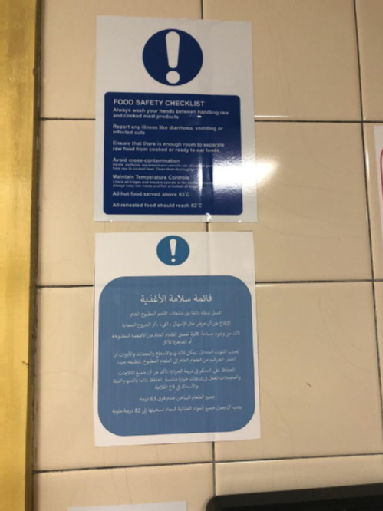
Contextualisation
The study was based in Coventry which has recently won the title of Coventry City of Culture 2021. Coventry has welcomed more than 100 refugee families through the Resettlement VPR and VRC schemes over the past 5 years. We used census data about Coventry from 2011 to contextualise our expectations before commencing our fieldwork. The 2011 census for Coventry states the top 5 most spoken languages in the area, in the following order: Panjabi (2,3%), Polish (2%), Gujuarti (0.8%), Urdu (0.8%), and Arabic (0.6%). As such, we were expecting to see a presence of these languages, among others, in the linguistic landscape.
Our sites reflect our interest in the perspectives of multilingualism in Coventry through the eyes of newly arrived inhabitants and the service providers who work closely with them. St Francis of Assisi church, located in the north of Coventry, is one amongst partner organisations which form the Integration Project in Coventry. This was our first fieldwork site, which we classified as public on the basis of its services. From Monday to Saturday, the Church provides a supportive environment for refugees in the community, in particular those who need help with job searches, childcare and English language learning. The second research site was classified as a service area, given its private function. This was a social enterprise café which the church has been leading for over a year now. The café provides a vegan middle eastern cuisine and recruits Syrian and Iraqi refugees amongst its staff. We were lucky to be granted access to the kitchen to gather data on multilingual signs. Our research in the two sites was conducted on a week day, when the church is open for community activities, in order to gather data from the multicultural and multilingual nature of this type of organisation. Data taken from the ‘Building Bridges 4th Quarter Data’, a class offered within the church, states that Arabic, Romanian, Hindi and Urdu to be the top languages spoken. Within this one class alone there are also speakers of Hungarian, Asante, Twi, Bulgarian, Turkish, Swahili, Punjabi, Zaghawa, Marathi, Polish, Chinese and Tigrinya. Our third site of enquiry was the Pool Meadows Bus Station, but as we were unable to collect extensive data in this location due to practical constraints, this paper will focus on the findings from our first two sites.
Methodology
The observational research took place during an entire day at Coventry. The team of two students from Monash University and three from the University of Warwick embarked on the ethnographic study to answer the research question of “How important is multilingualism for the identity of Coventry as a city?”. We collected both quantitative and qualitative data through observational research, semi-structured interviews and photographs of signs.
51 images were captured in total while surveying our chosen sites and some surrounding areas on our way from the church to the restaurant and bus station, as shown below.
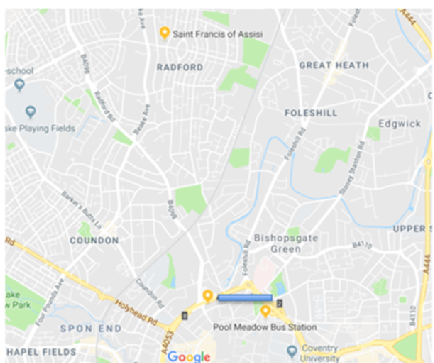
Photographs were then analysed as a group and categorised according to their language and the categories of official/unofficial and mutual/non-mutual translation. A set of interviews were also conducted in the two main sites: five interviews in English and one in Arabic. They addressed a total of 15 interviewees, six males and nine females. Relevant sections were selected for the analysis of the project.
Results & Discussion
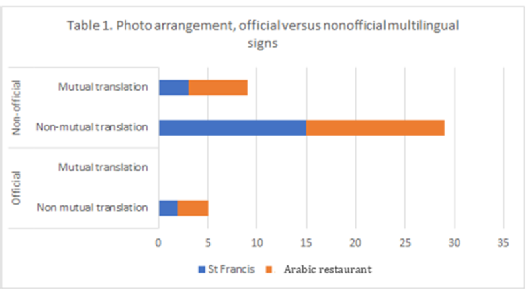
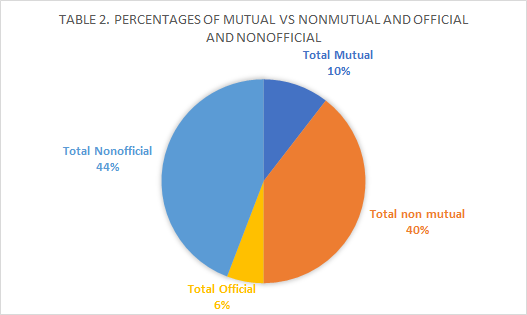
Our findings showed trends contrary to implications from the 2011 census data, which suggested that the most spoken languages were the following, in order of highest to lowest and percentage of speakers in the population: Panjabi (3.9%); Polish (3.9%); Urdu (3.1%); Romanian (1.7%); and Bengali (1.6%) (Coventry City Council, Demographics). Yet in both St Francis of Assisi and the social enterprise café there was an overwhelming presence of monolingual English signs, which included universal, image-based signs. This contrasts with the highly multilingual target audience and implies an underlying assumption that most readers will speak the lingua franca of English. However, our observations confirmed that many speakers are not highly proficient in English, and that some misunderstandings could be avoided with more multilingual signage.
When interviewed, participants of the church program were enthusiastic about the need to learn English to allow businesses and the city as a whole to develop; to be unrestricted in their daily tasks and interactions; and, in many cases, to become more “like” the members of their host community. No participants mentioned a need to maintain their heritage language. Instead, when asked about their perceptions of multilingualism and its importance for the city, they focused on their need to learn English. This implies that they have internalised the values of their host country, which appears to support a monolingual, English-centric language policy for migrants. Nonetheless, there was support for the hypothetical introduction of multilingual signs in the city, particularly from speakers of non-Roman alphabet languages like Arabic and Hindu. The same speakers also alluded to the controversy and difficulty of choosing which language to include on official signs.
Coventry’s lack of official signage suggests a disconnect between language rates in the community and language policy. The percentage of English signs appears to suggest a healthy ratio of multilingual signs in Coventry. However, many of those multilingual signs came from the kitchen of the café, which is a staff-only area, and is not visible to the dining public. The restaurant’s identity is anglicised to the public, as outside of the kitchen there is no evidence of multilingualism. Thus the restaurant aligns with speakers’ perceptions of multilingualism in Coventry, and is representative of the city’s approach to multilingualism as a whole: it builds its reputation on being a multicultural space, not a multilingual environment.
Limitations
While the trends we have found are worth considering, our data contains some limitations. Firstly, given the very specific locations and context of our research, our data reflects the linguistic reality of relatively recently arrived refugees, rather than the wider multicultural (and monolingual) community of Coventry. Secondly, we were unable to complete a comprehensive survey of the area due to time and practical constraints. Therefore our data is not reflective of Coventry as a whole, but provides some insight into the multilingual realities of its speakers.
Future studies could explore language policy and the regulation of signs as put up by businesses and individuals, and how this aligns with the community’s requirements and reality. Further research following the next census in 2021 could provide a more comprehensive and accurate analysis of the relationship of population, country of origin, language and the support that government policy provides for its multilingual speakers in the city of Coventry.
Conclusion
Our findings suggest that Coventry’s multicultural identity is more pronounced than its multilingual identity. There are plenty of instances of multiculturalism, but very few examples of multilingualism. The identity of Coventry seems to rely on promoting a public acceptance and image of multiculturalism, in line with the ‘city of culture’ advertising, without actually acknowledging the plethora of languages present in the population.
References
Ben-Rafael, E, Shohamy, E, Hasan Amara, M & Trumper-Hecht, N, 2006 “Linguistic Landscape as Symbolic Construction of the Public Space”, The Case of Israel, International Journal of Multilingualism, vol.3 no.1, pp.7-30, DOI: 10.1080/14790710608668383
Coventry City Council 2019, About the Local Area, fact sheet, viewed June 30 2019, https://www.coventry.gov.uk/info/195/facts_about_coventry/2450/headline_insights/3
Signs of (Linguistic) Life: What Coventry’s Linguistic Landscape Says about Its Discourse on Multilingualism
Elizabeth Bryer, Bara Dankova, Kathryn Macfarlane, Enung Rostika & Helena Wall
Background
We are a multidisciplinary group of students of various levels from the University of Warwick, UK and Monash University, Australia. We explored the linguistic landscape of Coventry, a city with a diverse population and the UK City of Culture 2021, posing the following research questions:
- What difficulties do institutions encounter in attempting to provide services to multilingual demographics? How do they attempt to cater to diverse populations through signs?
- How does language use in signs in linguistic landscaping relate to discourse of multilingualism and multiculturalism in Coventry?
There are two viewpoints regarding the extent to which host and migrant languages should be used. One viewpoint stresses the immense practical importance of messages being translated into the migrant’s language, as 'the role of translation in determining their fate is particularly stark' (Cronin, 2006, p. 46), with potential consequences ‘tantamount to a death sentence’ in the event of misunderstandings leading to an individual being denied asylum (Pollabauer, 2004, p. 144). The other viewpoint recommends immersion in the host language to facilitate acquisition, emphasising the 'primacy of communicative competence’ in the host language ‘as a means of economic integration and social survival' (Cronin, 2006, p. 52).
The implications of these contrasting viewpoints extend beyond the immediate concerns of establishing oneself in the host country to contribute to the construction of identity. The issue of identity is at the heart of the conflicting philosophies of multiculturalism and interculturalism. The multiculturalist approach argues that, for minority groups to be recognised as equal, their 'specific experience, cultural and social contributions' must be 'publicly affirmed and recognised' (Young, 1990, p. 37), a key component of which is recognition of minority languages. Interculturalism, in contrast, involves promoting interaction, understanding and integration (Ging & Malcolm, 2004, p. 127).
What we did
We visited two sites in Coventry targeted for use by the migrant community. The first was St Francis of Assisi Church, Radford, which serves as a community centre for migrants of diverse national, cultural and religious backgrounds. The second was a social enterprise vegan restaurant organised by the St Francis Employability Skills team and staffed by refugees. We collected data through photographing signs and interviewing people at the sites. Our interviewees at the church included the Employability Skills Programme Coordinator, English speaking (n=3) and non-English speaking (n=7) clients, and volunteers serving as teachers (n=1), and staff from another migrant-focussed service provision project (n=2). At the vegan restaurant, we interviewed the restaurant manager, who was a member of the migrant community.
For the purpose of our fieldwork, we defined as 'sign' any document that was affixed to a surface and included text. We classified those we photographed according to author: our first category, which we called 'Official A', was any sign that complied with an external governing body, including fire exit and food handling signs.
Official A: Fire exit sign
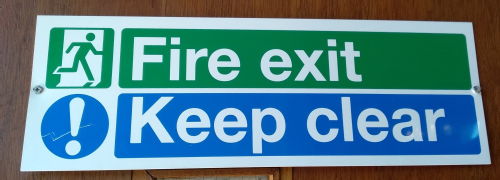
Our second category, 'Official B', were signs mounted by the organisation itself, which turned out to be the majority of our data. These had an informative or community-building function. They identified staff and volunteers, described the activities of the church and the relationship these activities had with the denomination’s doctrine, and depicting job search assistance.
Official B: Activity schedule
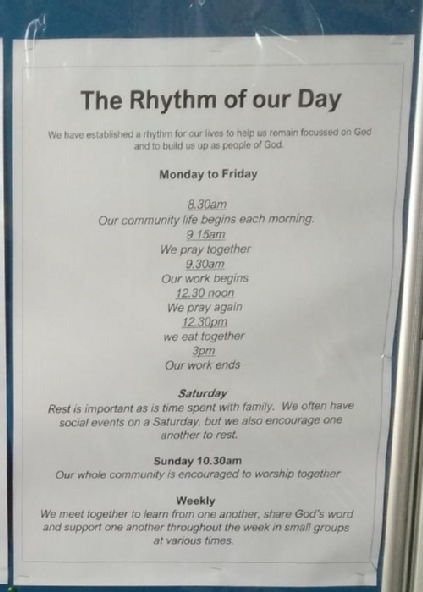
Our final category, 'Unofficial', were signs authored by members of the community. These were notes handwritten by community members asking others to pray for loved ones experiencing difficulties or health issues.
Unofficial: Prayer noticeboard
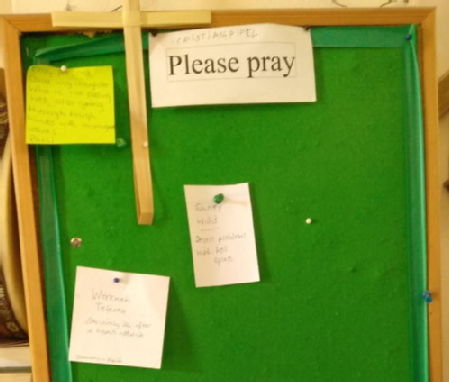
We further classified these according to whether they were written in English only ('monolingual') or included other languages as well ('multilingual'), with the latter category further identified as either 'mutual' (when the same message is represented in both/all languages) or 'non-mutual'.
What we found
Signs
The results were as follows:

As can be observed above, most signs were authored by the organisation. We identified a single multilingual sign positioned near the church building entrance. The mutually translated sign saying 'welcome' in numerous languages was purely symbolic rather than informative, as the languages present did not match the demographic information of service users. This represents the church as an inclusive and multilingual environment.
The only multilingual welcome sign at the entrance
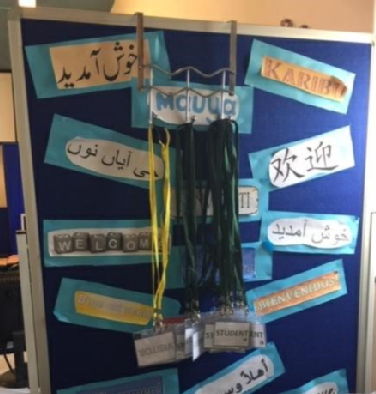
The fact that all of the official signs put up by external authorities were in English hints at an official language policy that does not privilege multilingual signage. It is reflective of the church’s focus on teaching English to immigrants and socializing them into the UK society. It was noted that a job provision sign showing volunteer roles available in the space did not include a role for an interpreter or Arabic language teacher.
Volunteer roles available
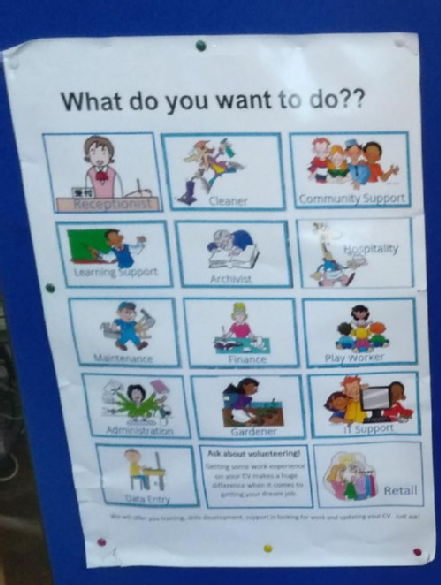
The exclusively English unofficial signs suggest that migrant community members have internalised this policy, seeing the church as a place where they immerse themselves in English rather than share their own language.
At our secondary research site, the vegan restaurant, most signs such as menus and decorative posters were also in English. The only trace of its Middle Eastern origins is the imagery used in the restaurant’s logo (not shown here for reasons of confidentiality).
Interviews
The key themes to emerge from the interviews provided insight into the underlying discourse on multilingualism in Coventry. The key difficulties encountered in providing Employability Skills and English Language services to their multilingual clientele were described as resource constraints, including the following:
- Age and condition of the building (in need of repairs)
- Lack of adequate spaces
- Availability of staffing - mainly volunteer-driven
- Funding to address the physical and human resource issues
Linguistic diversity was not perceived by staff as a barrier to service provision; the use of images, gestures and modified/simplified speech was seen as adequate to bridge any communication gap. Yet this was observed not always to be effective. For example, a staff member greeted a client, who mimed pain in his back and putting something in his mouth. This was interpreted as wanting food, so directions to the kitchen area were provided, whereas the client was indicating that he was taking medication for his back pain.
Likewise, the lack of translated signs and documentation was not seen as a barrier to informing potential clients of the availability of services. The target client population is refugee and migrant communities needing assistance with employability and English-language skills.
This word-of-mouth dissemination of services appears to be working; clients expressed that there was no difficulty in accessing information and found the various services welcoming and helpful. The English-only environment of the Centre was seen as both a way of providing a lingua-franca among linguistic groups, and as assisting new arrivals’ English-language acquisition through a full-immersion approach. Non-English-speaking clients echoed the viewpoint that acquiring English was the essential key to successful integration:
'We need to learn their language in order to be like them.'
The discourse from staff, volunteers and clients at both the church and the restaurant was consistently focussed on interculturalism rather multiculturalism;
'Young people ...don’t ... see the multiculturalism anymore… You shouldn’t see the multiculturalism, should you? Because [when] you see the difference, you say ‘why is that person here?’. Once you accept it, you don’t see it.'
Conclusions
Coventry appears to be achieving its goal of being a diverse city in which all cultures are welcomed. The numerous initiatives as part of the city’s migrant and refugee policies, and in particular those linked to the 2021 City of Culture project, are creating a vibrant and energetic momentum towards integration. However, the discourse is heavily focussed on interculturalism rather than multiculturalism.
Multilingualism was not observed in the data collected as being a part of either official or non-official discourse in Coventry. While there is recognition of the diverse linguistic backgrounds of Coventry’s population, the focus is very much on the acquisition of English as a means of successful integration for migrants. However, to pursue a multicultural strategy which excludes multilingualism is to negate the central role of language in the expression of culture.
Multiple benefits of mother-tongue maintenance have been recognised;
- as a strategy for developing the linguistic capital of the host nation/city (Lo Bianco, 1987; Clyne, 2008), and
- as a means of facilitating cognitive development and academic achievement for minority-language children (Cummins, 1978; Schmid, 2001)
National and local policies as well as on-the-ground initiatives all have a role to play in promoting multilingualism through the maintenance of community languages. We hope to see the 2021 City of Culture project used as a springboard for Coventry to become a leader of multilingualism in the UK, contributing to a shift away from the ‘monolingual mindset’ described by Clyne (2008) towards a culture which embraces, celebrates and promotes multilingualism, expanding the discourse from its current interculturalist viewpoint to one which truly embraces multiculturalism.
References
Clyne, M. (2008). The monolingual mindset as an impediment to the development of plurilingual potential in Australia. Sociolinguistic Studies, 2(3), 347-366.
Coventry 2021 City of Culture https://coventry2021.co.uk/ accessed 29/06/2019
Cronin, M. (2006). Translation and identity. Abingdon: Routledge.
Cummins, J. (1978) Educational Implications of Mother Tongue Maintenance in Minority-Language Groups, The Canadian Modern Language Review, Volume 34 Issue 3, pp. 395-416
Lo Bianco, J. (1987). National policy on languages. Australian Review of Applied Linguistics and Education, 10(2), 23-32.
Pollabauer, S. (2004). ‘Interpreting in asylum hearings: Issues of role, responsibility and power.’ Interpreting, 6(2), 143-180.
Schmid, Carol L. (2001). Educational Achievement, Language-Minority Students, and the New Second Generation. Sociology of Education Vol. 74, Extra Issue: Current of Thought: Sociology of Education at the Dawn of the 21st Century, pp. 71-87
Young, I. M. (1990). Justice and the politics of difference. Princeton, NJ: Princeton University Press.
The monolingual linguistic landscape of Coventry and what it means for its minorities
Barbora Danková
Introduction
The following will look at the linguistic landscape of Coventry in respect to the following research questions:
- What is the difference between language use in the linguistic landscape and the language use presented in the census data?
- What is the prediction for the integration of minorities in Coventry based on the linguistic landscape?
Methodology
The data for the following project was collected in June 2019 during the inaugural Sprinter School in Multilingualism and Diversity as part of a bigger linguistic landscaping project by the University of Warwick, UK and Monash University, Australia.
Research site
Photographs of signs were taken at the St Francis of Assisi Church in Radford, Coventry and various interviews with the church staff, volunteers and clients were recorded at the same site. The St Francis of Assisi Church in the north of the city still runs the traditional religious service on Sundays, but throughout the week it transforms into a community centre open to anyone seeking help with job applications, CV advice, ESOL lessons, etc. and provides assistance to migrants of all backgrounds wanting to integrate into the local community.
Sign outside the church describing activities on offer

Classification
To be considered a sign each item had to be attached to a surface and include text. Signs were further divided according to their author into three groups: those put up by an external authority, such as health and safety signs, those authored by the organisation itself, which included posters describing activities of the church as well as its function as a community centre, and the last category were signs created by the community members themselves; handwritten notes asking others to pray for them.
Health and safety sign put up by an external authority

Employability assistance poster put up by the church
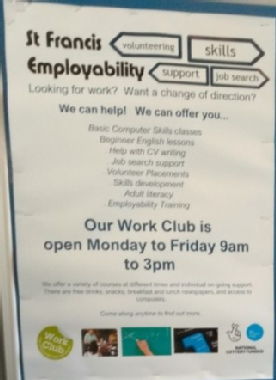
Messages asking for prayers put up by the clients of the church
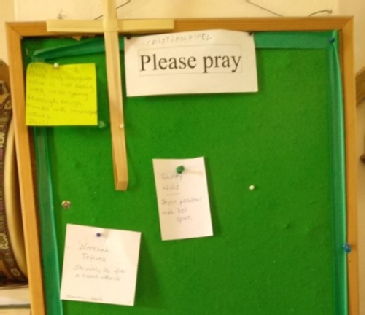
The same signs were also categorised into monolingual (English only) and multilingual (including other languages), which were then split into mutual (same message is conveyed in all languages) and non-mutual translations (Backhaus, 2006, p. 58).
Findings
Census data
Based on the 2011 Coventry census, one would expect to see Punjabi (2.3%), Polish (2.0%), varieties of Chinese (0.8%), Gujarati (0.8%), Urdu (0.8%) or Arabic (0.6%) besides English (86.1%). However, it is important to mention that the 2011 census clearly represents the population of Coventry from eight years ago. Taking the current political situation into consideration, the upcoming census in 2021 might provide a more accurate comparison.
Statistics from the church itself
According to an associated integration project called Building Bridges, the three most spoken languages inside the church besides English are Arabic, Hindi and Urdu. Other visitors also speak a number of other minority languages.
Data from Building Bridges: languages spoken by clients of the church
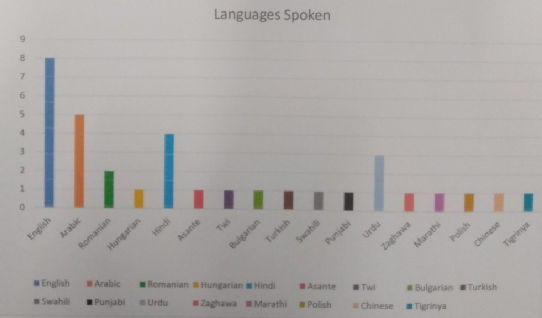
Data from the linguistic landscaping project
Out of the total of 99 signs, five monolingual signs created by external authorities were found alongside three monolingual signs authored by members of the community. The vast majority of the data were signs put up by the church itself (n=91), out of which a single one contained multiple languages (1.1%), all conveying the same message.
The only mutually translated multilingual sign by the entrance

Analysis of signage and interview data
Function of signs within the church
The one multilingual sign near the entrance saying 'welcome' in a number of languages does not necessarily represent the languages of the visitors of the church. Rather than communicating vital information to those who do not understand English it is a symbol of inclusivity and openness to speakers of all languages.
All signs authored by external authorities were in English, which suggests that there is no official language policy in place which would insist that information be presented in languages other than English. The exclusive use of English in signs put up by community members indicates that the clients have internalised the church as an English speaking environment. The fact that these are private messages and their authors are aware that some of the other visitors do understand their language creates an expectation to see the language used in these notes.
Why English only?
From the perspective of the church, giving information in certain languages but not others might be seen as excluding speakers of languages which are not represented, so they would rather not use any other language than English.
Another reason for the lack of multilingual signage, as explained by the Employability Skills Programme Coordinator, is that the church developed into what it is now by adapting to the demands and necessities of newly arrived refugees and asylum seekers. Five years ago, the place only served the English speaking majority as a traditional church in comparison to the Coventry Refugee and Migrant Centre, which was specifically set up to target the Arabic speaking demographic among others.
Conclusions
This paper examined the linguistic landscape of the St Francis of Assisi Church in Coventry and compared the language use to the latest census data. The relationship between languages used and the process of integration of migrants into the host community was also studied.
The overall 2011 Coventry census data does not match the statistics from the church and neither of these can explain the language used in the signs photographed in and around the building. At the research site, there was a single multilingual sign and its purpose was mostly symbolic. The lack of languages other than English at the church has two explanations. One has to do with striving for complete inclusivity and the other with the emergence of the community centre.
The clients of the church are fully immersed in English when they come to the church and have internalised it as a place where they learn and practice English rather than sharing their own languages.
References
Backhaus, P. (2006). Multilingualism in Tokyo: A look into the linguistic landscape. International Journal of Multilingualism. 3(1), 52-66. doi: 10.1080/14790710608668385
Kivisto, P. (2003). Social spaces, transnational immigrant communities, and the politics of incorporation. Ethnicities, 3(1), 5-28. doi:10.1177/1468796803003001786
Office for National Statistics (2011). Census 2011. Retrieved from https://www.ons.gov.uk/census/2011census

